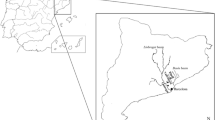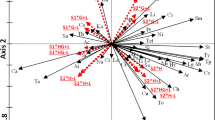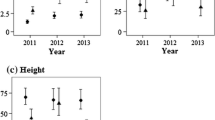Abstract
The Cape Floristic Region of South Africa is a global biodiversity hotspot threatened by invasive alien plants (IAPs). We assessed the effect of plant invasions, and their subsequent clearing, on riparian arthropod diversity. Foliage-active arthropod communities were collected from two native and one invasive alien tree species. Alpha- and beta-diversity of their associated arthropod communities were compared between near pristine, Acacia-invaded and restored sites. Arthropod alpha-diversity at near pristine sites was higher than at restored sites, and was lowest at invaded sites. This was true for most arthropod taxonomic groups associated with all native tree species and suggests a general trend towards recovery in arthropod alpha-diversity after IAP removal. Overall, arthropod species turnover among sites was significantly influenced by plant invasions with communities at near pristine sites having higher turnover than those at restored and invaded sites. This pattern was not evident at the level of individual tree species. Although arthropod community composition was significantly influenced by plant invasions, only a few significant differences in arthropod community composition could be detected between restored and near pristine sites for all tree species and arthropod taxonomic groups. Assemblage composition on each tree species generally differed between sites with similar degrees of plant invasion indicating a strong turnover of arthropod communities across the landscape. Results further suggest that both arthropod alpha- and beta-diversity can recover after IAP removal, given sufficient time, but catchment signatures must be acknowledged when monitoring restoration recovery.


Similar content being viewed by others
References
Anderson MJ (2001) A new method for non-parametric multivariate analysis of variance. Austral Ecol 26:32–46
Anderson MJ (2006) Distance-based tests for homogeneity of multivariate dispersions. Biometrics 62:245–253
Beerling DJ, Dawah HA (1993) Abundance and diversity of invertebrates associated with Fallopia japonica (Houtt. Ronse Decraene) and Impatiens glandulifer (Royle): two alien plant species in the British Isles. Entomologist 112:127–139
Blanchard R, Holmes PM (2008) Riparian vegetation recovery after invasive alien tree clearance in the Fynbos biome. S Afr J Bot 74:421–431
Bolker BM, Brooks ME, Clark CJ, Geange SW, Poulsen JR, Stevens MHH, White JSS (2008) Generalized linear mixed models: a practical guide for ecology and evolution. Trends Ecol Evol 2:127–135
Bray JR, Curtis JT (1957) An ordination of the upland forest communities of southern Wisconsin. Ecol Monogr 27:325–349
Bultman TL, Dewitt DJ (2008) Effect of an invasive ground cover plant on the abundance and diversity of a forest floor spider assemblage. Biol Invasions 10:749–756
Caterino MS (2007) Species richness and complementarity of beetle faunas in a Mediterranean-type biodiversity hotspot. Biodivers Conserv 6:3993–4006
Clarke KR (1993) Non-parametric multivariate analyses of changes in community structure. Aust J Ecol 18:117–143
Clavero M, Garciá-Berthou E (2005) Invasive species are a leading cause of animal extinctions. Trends Ecol Evol 20:110
Colwell RK (2009) EstimateS: statistical estimation of species richness and shared species from samples (software and user’s guide), version 8.2, http://viceroy.eeb.uconn.edu/EstimateS
Day JA, King JM (1995) Geographical patterns, and their origins, in the dominance of major ions in South African rivers. S Afr J Sci 91:299–306
Department of Agriculture, Forestry and Fisheries (2009) State of the forest report
Fischer DG, Hart SC, Schweitzer JC, Selmants PC, Whitham TG (2010) Soil nitrogen availability varies with plant genetics across diverse river drainages. Plant Soil 331:391–400
French K, Major RE (2001) Effect of an exotic Acacia (Fabaceae) on ant assemblages in South African fynbos. Austral Ecol 26:303–310
Galatowitsch S, Richardson DM (2005) Riparian scrub recovery after clearing of invasive alien trees in headwater streams of the Western Cape, South Africa. Biol Conserv 12:509–521
Goldblatt P, Manning JC (2000) Cape Plants: a conspectus of the Cape Flora of South Africa. Strelitzia 7:1–743
Govender P (2007) Status of seedling establishment pest of Acacia mearnsii De Wild. (Mimosaceae) in South Africa. S Afr J Sci 103:141–147
Gratton C, Denno RF (2005) Restoration of arthropod assemblages in a Spartina salt marsh following removal of the invasive plant Phragmites australis. Restor Ecol 13:358–372
Gray LJ (1993) Response of insectivorous birds to emerging aquatic insects in riparian habitats of a tallgrass prairie stream. Am Midl Nat 129:288–300
Halaj J, Wise DH (2001) Terrestrial trophic cascades: how much do they trickle? Am Nat 157:262–281
Harris RJ, Toft RJ, Dugdale JS, Williams PA, Rees JS (2004) Insect assemblages in a native (kanuka—Kunzea ericoides) and an invasive (gorse—Ulex europaeus) shrubland. N Z J Ecol 28:35–47
Herrera AM, Dudley TL (2003) Reduction of riparian arthropod abundance and diversity as a consequence of giant reed (Arundo donax) invasion. Biol Invasions 5:167–177
Horak J (2013) Effect of site level environmental variables, spatial autocorrelation and sampling intensity on arthropod communities in an ancient temperate lowland woodland area. PLoS One 8:e81541
Hortal J, Borges PAV, Gaspar C (2006) Evaluating the performance of species richness estimators: sensitivity to sample grain size. J Anim Ecol 75:274–287
Johnson MTJ, Lajeunesse MJ, Agrawal AA (2006) Additive and interactive effects of plant genotypic diversity on arthropod communities and plant fitness. Ecol Lett 9:24–34
Kemper J, Cowling R, Richardson DM (1999) Fragmentation of South African renosterveld shrublands: effects on plant community structure and conservation implications. Biol Conserv 90:103–111
Kessler M, Abrahamczyk S, Bos M, Buchori D, Putra DD, Gradstein SR, Höhn P, Kluge J, Orend F, Pitopang R, Saleh S, Schulze CH, Sporn SG, Steffan-Dewenter I, Tjitrosoedirdjo SS, Tscharntke T (2009) Alpha and beta diversity of plants and animals along a tropical land-use gradient. Ecol Appl 19:2142–2156
Lathrop RG, Windham L, Montesano P (2003) Does phragmites expansion alter the structure and function of marsh landscapes? patterns and processes revisited. Estuaries 26:423–435
Le Maitre DC, Richardson DM, Chapman RA (2004) Alien plant invasions in South Africa: case studies of the costs and benefits of management. For Ecol Manag 160:143–159
Lenat DR, Resh VH (2001) Taxonomy and stream ecology: the benefits of genus- and species level identification. J N Am Benthol Soc 20:287–298
Litt AR, Cord EE, Fulbright TE, Schuster GL (2014) Effects of invasive plants on arthropods. Conserv Biol 28:1532–1549
Longcore T (2003) Terrestrial arthropods as indicators of ecological restoration success in coastal sage scrub (California, USA). Restor Ecol 11:397–409
Magoba RNN, Samways MJ (2012) Comparative footprint of alien, agricultural and restored vegetation on surface-active arthropods. Biol Invasions 14:165–177
McCall BD, Pennings SC (2012) Disturbance and recovery of salt marsh arthropod communities following BP deepwater horizon oil spill. PLoS One 7:1–7
Milton SJ (1981) Above-ground biomass of Australian acacias in the southern Cape, South Africa. S Afr J Bot 47:701–716
Mlambo MC, Bird MS, Reed CC, Day JA (2011) Diversity patterns of temporary wetland macroinvertebrate assemblages in the south-western Cape, South Africa. Afr J Aquat Sci 36:299–308
Mokotjomela TM, Hoffmann JH (2013) Removal of post-dispersed seeds in Acacia cyclops thickets under biological control in South Africa. S Afr J Bot 88:260–264
Mucina L, Rutherford MC (2006) The vegetation of South Africa, Lesotho and Swaziland. Strelitzia 19. South African National Biodiversity Institute, Pretoria
Nel JL, Roux DJ, Maree G, Kleynhans CJ, Moolman J, Reyers B, Rouget M, Cowling RM (2007) Rivers in peril inside and outside protected areas: a systematic approach to conservation assessment of river ecosystems. Divers Distrib 13:341–352
Oliver I, Beattie AJ (1996) Invertebrate morphospecies as surrogates for species: a case study. Conserv Biol 10:99–109
PRIMER-E (2008) PERMANOVA and PRIMER 6. PRIMER-E, Ivybridge
Pryke JS, Roets F, Samways MJ (2013) Importance of habitat heterogeneity in remnant patches for conserving dung beetles. J Insect Conserv 22:2857–2873
Richardson DM, Macdonald IAW, Forsyth GG (1989) Reductions in plant species richness under stands of alien trees and shrubs in the Fynbos biome. J S Afr For 149:1–8
Robertson MP, Harris KR, Coetzee JL, Foxcroft L, Dippenaar-Schoeman AS, van Rensburg BJ (2011) Assessing the local scale impacts of Opuntia stricta (Cactacea) invasion on beetle and spider diversity in the Kruger National Park, South Africa. Afr Zool 46:205–223
Roets F, Pryke JS (2013) The rehabilitation value of a small culturally significant island based on the arthropod natural capital. J Insect Conserv 17:53–65
Sala OE, Stuart Chapin F III, Armesto JJ, Berlow E, Bloomfield J, Dirzo R, Huber-Sanwald E, Huenneke LF, Jackson RB, Kinzig A, Leemans R, Lodge DM, Mooney HA, Oesterheld M, LeRoy-Poff N, Sykes MT, Walker BH, Walker M, Wall DH (2000) Global biodiversity scenarios for the year 2100. Science 287:1770–1774
Samways MJ, Moore SD (1991) Influence of exotic conifer patches on grasshopper (Orthoptera) assemblages in a grassland matrix at a recreational resort, Natal, South Africa. Biol Conserv 57:117–137
Samways MJ, Sharratt NJ, Simaika JP (2011) Effect of alien riparian vegetation and its removal on a highly endemic river macroinvertebrate community. Biol Invasions 13:1305–1324
Schowalter TD, Crossley DAJ (1988) Canopy arthropods and their response to forest disturbance. In: Swank WT, Crossley D Jr (eds) Forest hydrology and ecology at Coweeta. Springer, New York, pp 207–218
Siemann E, Rogers WE (2003) Herbivory, disease, recruitment limitation, and success of alien and native tree species. Ecology 84:1489–1505
Simao MCM, Flory SL, Rudgers JA (2010) Experimental plant invasion reduces arthropod abundance and richness across multiple trophic levels. Oikos 119:1553–1562
Slobodchikoff CN, Doven JT (1977) Effects of Ammophila arenaria on sand dune arthropod communities. Ecology 58:1171–1175
Stewart AJA, Wright AF (1995) A new inexpensive suction apparatus for sampling arthropods in grassland. Ecol Entomol 20:98–102
Tallamy DW (2004) Do alien plants reduce insect bio-mass? Conserv Biol 18:1689–1692
Terlizzi A, Anderson M, Bevilacqua S, Fraschetti S, Włodarska-Kowalczuk M, Ellingsen KE (2009) Beta diversity and taxonomic sufficiency: do higher-level taxa reflect heterogeneity in species composition? Divers Distrib 15:450–458
Thuiller W, Richardson DM, Rouget M, Procheş Ş, Wilson JRU (2006) Interactions between environment, species traits and human uses describe patterns of plant invasion. Ecology 87:1755–1769
Toft RJ, Harris RJ, Williams PA (2001) Impacts of the weed Tradescantia fluminensis on insect communities in fragmented forests in New Zealand. Biol Conserv 102:31–46
van der Colff D, Dreyer LL, Valentine A, Roets F (2015) Invasive plants species may serve as a biological corridor for the invertebrate fauna of naturally isolated hosts. J Insect Conserv 19:863–875
van Wilgen BW, Reyers B, Le Maitre DC, Richardson DM, Schonegevel L (2008) A biome-scale assessment of the impact of invasive alien plants on ecosystem services in South Africa. J Environ Manag 89:336–349
van Wilgen BW, Forsyth GC, Le Maitre DC, Wannenburgh A, Kotzé JDF, van den Berg E, Henderson L (2012) An assessment of the effectiveness of a large, national-scale invasive alien plant control strategy in South Africa. Biol Conserv 148:28–38
Vosse S, Esler KJ, Richardson DM, Holmes PM (2008) Can riparian seed banks initiate restoration after alien plant invasion? Evidence from the Western Cape, South Africa. S Afr J Bot 74:432–444
Walther BA, Morand S (1998) Comparative performance of species richness estimation methods. Parasitology 116:395–405
Walz U (2011) Landscape structure, landscape metrics and biodiversity. Living Rev Landsc Res 5:3
Williams KS (1993) Use of terrestrial arthropods to evaluate restored riparian woodlands. Restor Ecol 1:107–116
Wishart MJ, Davies BR, Stewart BA, Hughes JM (2002) Examining catchments as functional units for the conservation of Riverine Biota and maintenance of biodiversity. WRC report no. 975/1/02. Water Research Commission, Pretoria, South Africa
Witkowski ETF (1991) Effects of invasive alien acacias on nutrient cycling in the coastal lowlands of the Cape Fynbos. J Appl Ecol 28:1–15
Wolfe LM (2002) Why alien invaders succeed: support for the escape-from-enemy hypothesis. Am Nat 160:705–711
Ziesche TM, Roth M (2008) Influence of environmental parameters on small-scale distribution of soil-dwelling spiders in forests: what makes the difference, tree species or microhabitat? For Ecol Manag 255:738–752
Zuur AF, Elena NI, Elphick CS (2010) A protocol for data exploration to avoid common statistical problems. Methods Ecol Evol 1:1–14
Acknowledgments
Thanks to Marno Fourie and Oliver Kambaj for field assistance and reviewers for helpful suggestions to improve this manuscript. We thank private landowners and CapeNature for access to field sites (Permit Number: AAA008-00027-0028). This study was funded by the DST/NRF Centre of Excellence in Tree Health Biotechnology.
Author information
Authors and Affiliations
Corresponding author
Ethics declarations
Conflict of interest
The authors declare that they have no conflict of interest.
Rights and permissions
About this article
Cite this article
Maoela, M.A., Roets, F., Jacobs, S.M. et al. Restoration of invaded Cape Floristic Region riparian systems leads to a recovery in foliage-active arthropod alpha- and beta-diversity. J Insect Conserv 20, 85–97 (2016). https://doi.org/10.1007/s10841-015-9842-x
Received:
Accepted:
Published:
Issue Date:
DOI: https://doi.org/10.1007/s10841-015-9842-x




